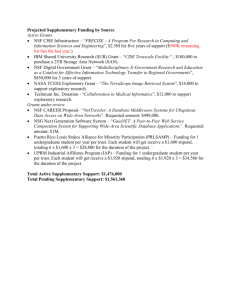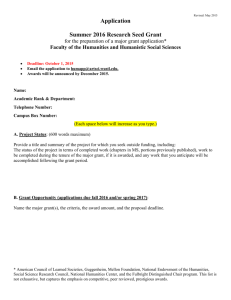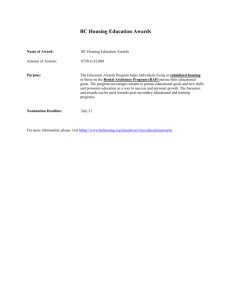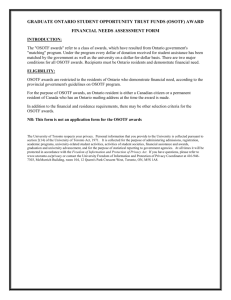Freeman_nsfgrf_at_SEWP_oct2005_b
advertisement
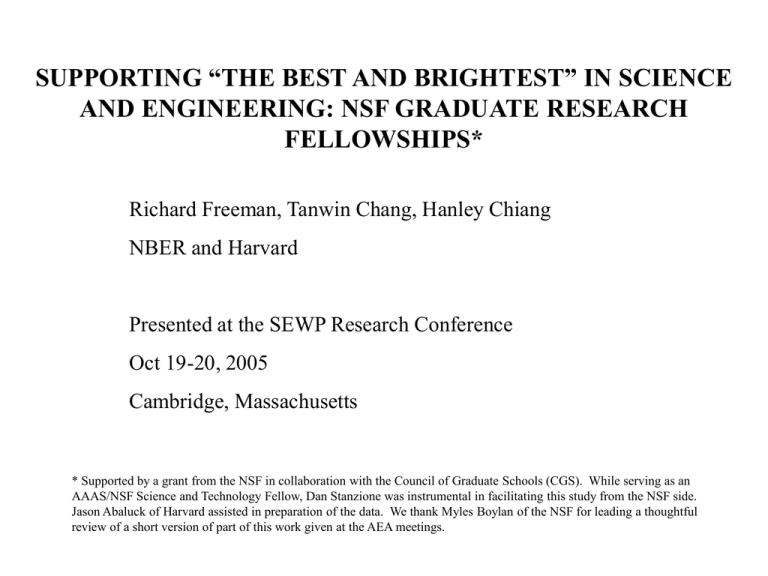
SUPPORTING “THE BEST AND BRIGHTEST” IN SCIENCE AND ENGINEERING: NSF GRADUATE RESEARCH FELLOWSHIPS* Richard Freeman, Tanwin Chang, Hanley Chiang NBER and Harvard Presented at the SEWP Research Conference Oct 19-20, 2005 Cambridge, Massachusetts * Supported by a grant from the NSF in collaboration with the Council of Graduate Schools (CGS). While serving as an AAAS/NSF Science and Technology Fellow, Dan Stanzione was instrumental in facilitating this study from the NSF side. Jason Abaluck of Harvard assisted in preparation of the data. We thank Myles Boylan of the NSF for leading a thoughtful review of a short version of part of this work given at the AEA meetings. Stipends: Funding Modes for Graduate Education • • • • • Regular payments (distributed to approx. 2/3 of S&E grad students) Three main types of stipends: – Fellowships: competitive awards (13% of FT grad students) – Teaching Assistantships: teaching required – Research Assistantships: research required Multiple Funders: – Government: NSF, NIH, etc. – Universities, Foundations, Individuals Postdocs may also receive stipends, often via fellowships Other forms of funding: – Self-financed: savings/family – Loans – Traineeships Stipends: Potential Supply-Side Policy Tool • Time in graduate school/postdoc represents up to ¼ of a scientist’s career. (6 years grad school + 4 years postdoc = 10 years out of 40 year career) – Salary over first ¼ will have a non-trivial effect on lifetime earnings – larger than later $ because of discounting – Signalling effect to student can also be important • Government fellowships may be restricted to citizens/permanent residents, primarily affecting US individuals (Gov’t awards ~1/3 of S&E Fellowships) • Quantity and price dimensions – policy can alter number of awards and value of awards NSF Graduate Research Fellowship Program (1952 - 2004) 30 25 2500 Annual Stipend Amount 20 2000 15 1500 10 Awardees 5 0 1950 1000 500 1960 1970 1980 1990 2000 The number and value of GRF awards vary over time. 0 # of People Thousands of Constant Dollars (2003) 3000 Primary Data Source: NSF’s Cumulative Index (CI), including Follow-Up Data Summary for Key Data in Total Time Period the GRF Datafiles Panel Ratings Reference Score GRE Quant GRE Verbal GPA Ethnicity Gender Data Available 1976 - 1993 1994 - 1998 1999 2000 - 2004 1954 - 1993 1994 - 1998 1952 - 2004 1952 - 2004 1955 - 1998 1976 - 2004 1981 - 1987 1988 - 2000 2000 - 2004 1952 - 2000 2001 - 2004 Records Overall Award Rate 1952 - 2004 271,391 13.50% Mean STD Full Range 328 315 3.11 2.90 24.2 1.91 691 606 3.49 115 100 to 600 118 100 to 600 1.02 1.00 to 6.00 0.85 1.00 to 4.99 8.7 10 to 70 0.65 1 to 7 100 200 to 800 104 200 to 800 0.40 1 to 4 (1, 2, 3, 4, 5) (1, 2, 3, 4, 5, 6, 7, 8, 9) (A, B, C, D, E, F, H, I, J) (t, f) or (y,n,b) (m, f) (m, f, b) GRF Awardees as Proportion of S&E Bachelors (1952 - 2004) 8 Thousands of S&E Bachelors Bachelors 7 400 6 5 300 4 200 Awardees 3 2 100 1 0 1950 1960 1970 1980 1990 2000 GRF Awardees per Thousand Bachelors 500 0 The number of awards per S&E baccalaureate has shifted downwards Huge Changes in Distribution of GFRP Awardees by Field: Decline of Physical Sciences 100% Mathematics Computer Science 80% Physics Geoscience 60% Chemistry Engineering 40% Life Science 20% Social Science Psychology 19 52 19 55 19 58 19 61 19 64 19 67 19 70 19 73 19 76 19 79 19 82 19 85 19 88 19 91 19 94 19 97 20 00 20 03 0% Because of Changes in Applicants by Field 100% Mathematics Computer Science 80% Physics Geoscience 60% Chemistry Engineering 40% Life Science 20% Social Science Psychology 19 52 19 55 19 58 19 61 19 64 19 67 19 70 19 73 19 76 19 79 19 82 19 85 19 88 19 91 19 94 19 97 20 00 20 03 0% What if NSF Did Not Regulate the Percentage of Awardees in Each Discipline? Our research implies that a shift to pure “measured scholastic” achievement would not necessarily benefit the hard sciences at the expense of the more qualitative sciences. Using linear probability model, found only modest shifts among most disciplines. The biggest increases in awardees were for Psych and Social Science at the expense of Engineering! Why? Mean Applicant Quality Engineering Psychology Soc Science Quant 728 653 667 Verbal 573 615 642 GPA 3.67 3.57 3.60 Refs 0.05 0.27 0.19 Analyzing the effect of changes to stipends on S&E workforce: Quantity (N) and Quality (Q) When the number or value of awards changes – What happens to the number and quality of applicants, awardees, and graduates? • N = SN(#awards, $awards, X) • Q = SQ(#awards, $awards, X) 10000 9000 8000 7000 6000 5000 4000 3000 2000 1000 0 1968 1.2 1 0.8 0.6 0.4 0.2 Stipend/Alternative Appplicants GRFP Applications and Relative Value of GRFP Stipend, 1968-2004 0 1973 1978 1983 Applicants 1988 1993 1998 2003 Stipend/Alternative Wage Source: NSF, Division of Graduate Education, Cumulative Index of the GRF Program and related datasets. Bachelor’s degree data tabulated by National Science Foundation/Division of Science Resources Studies; data from Department of Education. 10000 9000 8000 7000 6000 5000 4000 3000 2000 1000 0 1979 4 3.5 3 2.5 2 1.5 1 0.5 1984 1989 Applicants 1994 1999 Unemployment Rate (%) Appplicants GRFP Applications and College Graduate Unemployment Rate, 1979-2004 0 2004 Unemp Rate Source: NSF DGE, Cumulative Index of the GRF Program and related datasets. Bachelor’s degree data tabulated by National Science Foundation/Division of Science Resources Studies; data from Department of Education. Unemployment data from estimated from the annual Current Population Survey (CPS) Outgoing Rotation Group, Bureau of Labor Statistics. 800 1.2 780 1 0.8 760 0.6 740 0.4 720 700 1965 0.2 1975 GRE Quan 1985 1995 Stipend/Outside Salary GRE Score GRE Quantitative Scores of Awardees and Relative Stipend Value, 1968-2004 0 2005 Stipend/Outside Salary Source: NSF DGE, Cumulative Index of the GRF Program and related datasets. Salary data estimated from the Integrated Public Use Microdata Series (IPUMS) of the March Current Population Survey. 720 710 700 690 680 670 660 650 640 630 620 1965 GRE Verbal 1.2 1 0.8 0.6 0.4 0.2 1975 1985 Detrended Verbal 1995 Stipend/Outside Salary GRE Scores GRE Verbal Scores of Awardees and Relative Stipend Value, 1968-2004 0 2005 Stipend/Outside Salary Source: NSF DGE, Cumulative Index of the GRF Program and related datasets. Salary data estimated from the Integrated Public Use Microdata Series (IPUMS) of the March Current Population Survey. Linear Probability Model for the Impact of Scholastic and Demographic Variables on GRF Awards. 1955-98 Offered Award 1976-98 0.082 (0.001) 0.034 (0.001) 0.060 (0.001) 0.089 (0.002) 0.074 (0.001) 0.035 (0.001) 0.066 (0.001) 0.095 (0.003) 0.033 (0.002) 0.087 (0.004) 1976-98 0.170 (0.001) 0.022 (0.001) -0.010 (0.001) 0.019 (0.001) -0.010 (0.003) 0.037 (0.002) 0.077 (0.003) Yes Yes 207498 0.198 Yes Yes 107658 0.1793 Yes Yes 107597 0.2731 Panel Rating Reference Score GRE Quant/100 GRE Verbal/100 GPA Female Minority Field Effects Year Effects Observations R-squared Source: NSF, Division of Graduate Education, Cumulative Index of the GRF Program and related datasets. Determinants of the Number of GRFP Applicants, 1969-2004 Dep Var: ln(applicants in academic field in current year) (1) (2) (3) (4) Log(Bachelor's Degs) by Field in Current Yr Log(Stipend/Outside Salary) in Previous Yr 0.195 (0.057) 0.996 (0.084) Unemp Rate for College Grads Age 21-25 0.304 (0.063) 0.916 (0.060) 0.049 (0.013) Unemp Rate for All College Grads 0.298 (0.062) 0.852 (0.059) 0.516 (0.066) 0.772 (0.056) 0.104 (0.024) 0.094 (0.022) 0.349 (0.054) Yes Yes 234 0.9634 Log(Awards/Bachelor's Degs) by Field in Previous Yr Field Effects Field x Time Trend Observations R-squared Yes Yes 324 0.8931 Yes Yes 234 0.955 Yes Yes 234 0.9561 Source: NSF, Division of Graduate Education, Cumulative Index of the GRF Program and related datasets, as described in text. Outside salary are earnings of college graduates aged 21-25. Outside salaries and unemployment rates from Current Population Survey Determinants of Awardee Achievement, 1969 - 2004 GRE Quant GRE Verbal Log(Number of Awards) by Field in Current Yr Log(Stipend/Outside Salary) in Previous Yr Field Effects Field x Time Trend Observations R-squared GPA -10.6 (1.80) -21.8 (3.30) -0.087 (0.01) 29 3.3 35.4 6.1 -0.007 0.017 Yes Yes 324 0.8943 Yes Yes 324 0.684 Yes Yes 270 0.7354 Source: Tabulated from NSF, Division of Graduate Education, Cumulative Index of the GRF Program and related datasets, as described in text. Outside salary are earnings of college graduates aged 21-25, tabulated from Current Population Survey. Quality of GRFP Applicants on the Margin of Getting and Award, 2004 GRE Quant GRE Verbal 800 750 700 650 600 550 1 2 3 4 5 6 7 8 9 10 Source and Notes: All persons to the left of the line were given awards. All persons to the right of the line did not get awards. The numbers relate to groups of 50 persons, ordered by the estimated probability they would win an NSF award. The 5th group consists of 50 awardees with the lowest probability of getting an award, the 4th group consists of 50 awardees with the next lowest probablity, and so on. The 6th group consists of the 50 nonawardees with the highest probablity of getting an award. The probabilities are predicted values from an OLS regression of an award receipt dummy variable on panel rating, female dummy, underrepresented minority dummy, and eight field dummies. Units for Stipend Budget: Dollars per $10 Million GDP Dollars Fellowships Fraction of Bachelors choosing to apply to GRF vs. total GRF stipend budget/GDP. 50 45 40 Bottom Line Message: 35 30 Students respond to spending on Government Fellowships 25 20 15 10 5 0 1950 1960 1970 1980 1990 2000 Applicants per 1000 S&E Bachelors Stipend Budget (Normalized by GDP) Source: NSF DGE, Cumulative Index of the GRF Program and related datasets. Data on the Gross Domestic Product (GDP) from the Bureau of Economic Analysis, an agency of the U.S. Department of Commerce. Conclusions • Verified that primary determinant of awardees are academic achievement. • Verified that women and minorities have higher chance of winning fellowship, compared to white men of similar attributes. • for every 10% increase in the stipend value, the number of applicants goes up by 8-10%. • the supply of applicants contains enough qualified candidates to allow for a sizable increase in the number of awards without greatly reducing measured skills. Further work to see if results of this study generalize to the population of stipend grantees requires detailed consideration of the entire market for all stipends … NSF are important but there are many other awarding agencies and groups. Fixed Rule Policy Scenario: # of awards 0.41% of S&E Bachelors Degrees $ of awards 115.8% of alternative wage ACTUAL PROGRAM CHARACTERISTICS Period 1968-1971 1972-1975 1976-1979 1980-1983 1984-1987 1988-1991 1992-1995 1996-1999 2000-2004 (Annual Averages) Awards As Stipend as Average Quality of % of S&E Awards % of Alt. Awardees Bach Wage Degrees Quant Verbal 921 0.35% 55.70% 745.2 692.8 511 0.16% 66.00% 751 693.8 504 0.17% 55.00% 753.1 703.6 460 0.15% 56.30% 746.9 693.1 520 0.16% 82.00% 759.6 696.5 807 0.25% 92.20% 766.3 692.9 794 0.22% 84.50% 762 681.2 820 0.21% 72.10% 751.1 660.3 915 0.23% 93.40% 753.2 633.9 HYPOTHETICAL PROGRAM CHARACTERISTICS Awards 1082 1285 1237 1261 1342 1330 1493 1580 1640 Predicted Quality of Awardees Quant 764.7 751 765.2 757.1 759.6 767.7 764.4 757.9 753.3 Verbal 715.2 693.8 710.4 696.6 688 690.1 678.6 662.8 628.8 Notes: “Hypothetical” characteristics denote those predicted to prevail if awards as % of S&E bachelor’s degrees had been maintained at 0.41% (its 1968 value) and stipend as % of alternative wage had been maintained at 115.8% (its 2004 value). Hypothetical changes in GRE Quant and GRE Verbal are based on coefficients in columns 1 and 3 of Table 7. In the calculations, actual numbers of bachelor’s degrees in 2002-2004 were imputed from 2000-2001 field-specific growth rates in earned bachelor’s degrees, and actual alternative wage in 2004 was imputed from 1983-2003 growth rate in salary of 21-25 yr olds with bachelor’s degrees.
